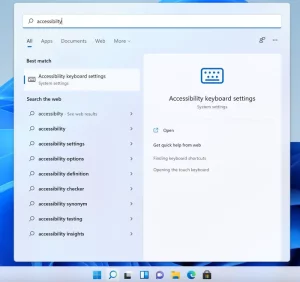Understanding Sticky Keys and Filter Keys: Purpose and Uses
Have any of you encountered the phrases “Sticky Keys” and “Filter Keys” when using Windows? These are two accessibility features that have been proven to enhance the user experience for individuals who have specific requirements. Let’s dig deeper into the concept of Sticky Keys and Filter Keys along with their advantages for diverse users.
What do Sticky Keys mean and how are they operated? Sticky Keys aim to modify the behavior of particular modifier keys, including [Shift] and [Ctrl]. While being held down, these keys are typically active. Immediately after you release them, the system forgets they were ever pressed. Nevertheless, simultaneous pressing of multiple keys might present a challenge for certain users. It may be hard to input specific key combinations, for instance, [Ctrl] + [Alt] +[Tab].
When Sticky Keys are enabled, the modifier keys “stick” until they are manually released or until a keystroke combination is completed. In other words, Sticky Keys make modifier keys behave more like locking keys. Customizing Sticky Keys offers a range of different options, like turning on confirmation sounds another possibility is that they will be disabled automatically when not needed anymore.
Opting for Sticky Key Functionality Can Be Beneficial Can Have Several Advantages
Sticky Keys offer several advantages Individuals who have specific needs can benefit from using Sticky Keys. For those who struggle to simultaneously press multiple keys, Sticky Keys offer another method for entering keyboard shortcuts. The specific attribute proves to be highly advantageous for individuals diagnosed with motor disabilities or conditions that hinder finger dexterity. By allowing users to input key combinations sequentially rather than simultaneously, By enhancing accessibility and increasing ease of use, Sticky Keys provide a valuable benefit.
Moreover, Sticky Keys are customizable, enabling users to modify the configurations according to their liking. For instance, people can opt for enabling auditory prompts when a modifier key is pressed or released, delivering feedback regarding the current state of the keys.

An Introduction to Filter Keys and How It Works
In opposition, Filter Keys play an antagonistic role in relation to typematic characteristics. If activated, Windows’ ability to recognize fast consecutive keystrokes is hindered by Filter Keys. Included in these bursts can be rapid streams of the same key or a simultaneous pressing of a cluster with different keys.
Suppressing or disregarding unintended keystrokes caused by conditions such as tremors or accidental key presses is the aim of Filter Keys. By setting a specific duration that a key must be held down to register, One benefit of Filter Keys is the prevention of unintended entry caused by accidentally striking keys. In order to ensure that only intentional input is identified. Similar to Sticky Keys, Filter Keys provide different options for adjusting audible confirmations and user preferences.
Enhancing the Accessiblity of Windows with Filter Keys
Filter Keys have an essential function in enhancing the accessibility of Windows for individuals with motor disabilities or conditions resulting in involuntary movements. People who have tremors or shaky hands, challenges may arise when typing, leading to frequent errors. By adjusting the Filter Keys settings, Minimizing unintended keystrokes and improving overall typing accuracy are goals that users can achieve
Additionally, Filter Keys can be a valuable tool for those learning to type. Promoting an intentional and attentive mindset towards keystrokes, which assists users in cultivating healthier typing habits.
Conclusion,
Sticky Keys and Windows also offers an important accessibility feature known as Filter Keys which addresses specific user requirements. are essential accessibility features in Windows that cater to specific user needs. While Sticky Keys enable users to execute key combinations sequentially, Filter Keys assist in preventing accidental and speedy keystrokes. The usability of Windows is improved for people with motor disabilities, hand tremors, or learning difficulties by these features, An inclusive computing experience is encouraged for all through these features
By understanding the uses and functionality of Sticky Keys and Filter Keys, Users can effectively utilize these features to cater to their individual demands.. By enhancing typing accuracy or streamlining keyboard shortcuts, they contribute significantly to fostering an accessible and convenient computing environment.










